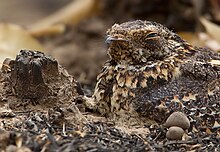Standard-winged nightjar
| Standard-winged nightjar | |
|---|---|

| |
| Breeding male | |

| |
| Non-breeding | |
| Scientific classification | |
| Domain: | Eukaryota |
| Kingdom: | Animalia |
| Phylum: | Chordata |
| Class: | Aves |
| Clade: | Strisores |
| Order: | Caprimulgiformes |
| Family: | Caprimulgidae |
| Genus: | Caprimulgus |
| Species: | C. longipennis
|
| Binomial name | |
| Caprimulgus longipennis Shaw, 1796
| |

| |
| Range map of Caprimulgus longipennis, breeding range marked as dark and non-breeding range marked as light | |
The standard-winged nightjar (Caprimulgus longipennis) is a nocturnal bird in the nightjar family. Previously placed with the pennant-winged nightjar (Caprimulgus vexillarius) in their own genus, it is native to Africa and displays extreme sexual dimorphism during the breeding season, wherein males will grow and perform display flights with broad ornamental flight feathers longer than their body.
Distribution and habitat
[edit]The standard-winged nightjar is a resident breeder in Africa from southern Senegal east to Ethiopia. It spends the non-breeding season in the Sahel region to the north. Its habitat includes lightly wooded savanna, with some scrub, as well as agricultural land in thickly wooded savanna.[2] It has been observed at elevations as high as 2,030 metres (1.26 mi) in Ethiopia,[3] but is typically found from sea level up to elevations of 1,400 metres (0.87 mi).[2]
Description
[edit]When roosting on the ground during the day, this medium-sized (20–23 centimetres (7.9–9.1 in) long) nightjar is mainly variegated grey, with a browner collar. It is a shadowy form with easy, silent moth-like flight; this nightjar is relatively short-tailed, and lacks white in the wings or tail. The song is a churring trill.[1]
The adult male grows a bizarre and unusual wing ornament during the breeding season which consists of a broad secondary flight feather[4] on each wing elongated to 38 centimetres (15 in), much longer than the bird's body. 20 centimetres (7.9 in) or more of this is bare shaft. In normal flight, these feathers trail behind, but in display flight they are displayed like standards.[2] Outside the breeding season, the female is distinguished from the male by its smaller size and similarity to the pennant-winged nightjar, notably the patch of white on the throat and dark barring on the belly.[5]
Behaviour
[edit]
Like other nightjars, the standard-winged nightjar feeds on insects in flight, their mouths opening wide for moths and beetles. It flies at dusk, when the highest quantity of prey is available, though its foraging patterns change depending on moonlight, with later, more nocturnal foraging correlated with higher levels of moonlight.[6] It may also feed on swarms of insects disturbed by fires and artificial lights.[7]
During breeding season, male and (less frequently) female standard-winged nightjars will gather in patches of soil with little vegetation to forage and for males to perform display flights.[6] Males with especially large ornamental feathers are considered as demonstrating their viability due to their ability to survive with such a burden.[4]
No nest is made; in each clutch, two elliptical, slightly glossy eggs are placed upon bare sandy soil.[2]
Nomenclature
[edit]Though the standard-winged nightjar was originally placed in the genus Caprimulgus as in its first identification by George Shaw in 1796,[8] it was later placed in the genus Macrodipteryx along with the pennant-winged nightjar.[2] A phylogenetic study done in 2010[9] indicated that the two species were better placed within Caprimulgus, and that the species are closely related despite having different morphology,[2] breeding ranges, and breeding seasons.[10]
References
[edit]- ^ a b BirdLife International (2016). "Caprimulgus longipennis". IUCN Red List of Threatened Species. 2016: e.T22690021A93257600. doi:10.2305/IUCN.UK.2016-3.RLTS.T22690021A93257600.en. Retrieved 12 November 2021.
- ^ a b c d e f Cleere, N.; Kirwan, G. M. (2020). del Hoyo, J.; Elliott, A.; Sargatal, J.; Christie, D. A.; de Juana, E. (eds.). "Standard-winged Nightjar (Caprimulgus longipennis), version 1.0". Birds of the World Online. Cornell Lab of Ornithology, Ithaca, NY. doi:10.2173/bow.stwnig1.01.
- ^ Ash, J. S.; Atkins, J.; Ash, Caroline P. J. (2009). Birds of Ethiopia and Eritrea: An Atlas of Distribution. London, UK: A&C Black. p. 209. ISBN 978-1-4081-0979-3.
- ^ a b Lovette, Irby J.; Fitzpatrick, John W., eds. (2016). Cornell Lab of Ornithology’s handbook of bird biology (3rd ed.). Wiley-Blackwell. p. 71. ISBN 978-1-118-29105-4. LCCN 2016003727.
- ^ Holyoak, D. T. (2001-07-19). Nightjars and Their Allies: The Caprimulgiformes. OUP Oxford. p. 362. ISBN 978-0-19-854987-1.
- ^ a b Jetz, Walter; Steffen, Jan; Linsenmair, Karl Eduard (December 2003). "Effects of light and prey availability on nocturnal, lunar and seasonal activity of tropical nightjars". Oikos. 103 (3): 627–639. doi:10.1034/j.1600-0706.2003.12856.x. ISSN 0030-1299.
- ^ Jackson, Hd (September 2003). "Another reason for nightjars being attracted to roads at night". Ostrich. 74 (3–4): 228–230. doi:10.2989/00306520309485398. ISSN 0030-6525.
- ^ Shaw, George; Nodder, Frederick Polydore (1797). "The Leona Goatsucker, Caprimulgus longipennis (Pl. 265)". The Naturalist's Miscellany (in Latin). 8 (LXXXIX). doi:10.5962/p.310808.
- ^ Han, Kin-Lan; Robbins, Mark B.; Braun, Michael J. (May 2010). "A multi-gene estimate of phylogeny in the nightjars and nighthawks (Caprimulgidae)". Molecular Phylogenetics and Evolution. 55 (2): 443–453. doi:10.1016/j.ympev.2010.01.023.
- ^ Maclean, G. L. (1997). "Pennant-winged Nightjar". In Harrison, J. A.; Allan, D. G.; Underhill, L. G.; Herremans, Marc; Parker, V. (eds.). The atlas of Southern African birds. Randburg, South Africa: Acorn Books and Russel Friedman Books, in association with the Trustees of the John Voelcker Bird Book Fund. ISBN 978-0-620-20729-4.

